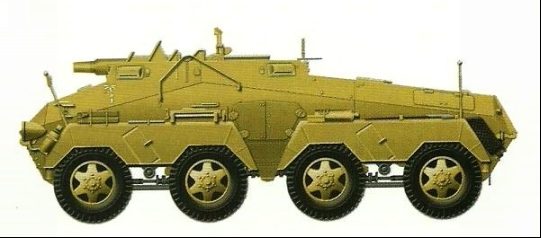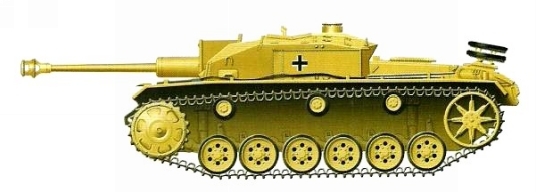The United States tanks rolled eastwards towards the waiting panzers and at 11:00 hrs battle was joined. The American light tanks drove forward, thirty of them seeking to destroy the panzers and quite unaware that during the night a battery of 8.8cm guns had been sited on the flank of their advance. As the tanks poured through the orchards advancing towards the German positions, they met not only the fire from 7.5cm tank cannon but also a battering from the fast-firing 8.8s. Within 15 minutes, eight American tanks lay smashed or burning on the battlefield. Other American squadrons went in in futile assaults and their efforts, too, were smashed by the fire of the 8.8s and that of six Panzer IVs. The Allied armoured weapon was shattered against the steely panzer defence.

Slowly Battle Groups Liider and Hudel fought their way towards the Medjerda river suffering casualties from the well directed Allied artillery fire, but with every yard gained, threatening to cut the main road. At dusk the protagonists broke off the tank fighting and left the battle to aggressive and violent infantry patrol clashes. Slightly, very slightly, but very certainly the Germans had gained the upper hand and were beginning to win the battle.
During the night of 2/3 December Panzer Grenadier reinforcements arrived for Battle Group Djedeida. The infantry component of this battle group had been too weak to drive the British from their .positions on the ridge above the village and, with no reserve immediately to hand and upon which he could draw, Fischer had airshipped to him from Europe two of the Grenadier Companies of 10th Panzer Division. These had barely arrived upon the battlefield when they were put into action and into an attack upon the British infantry.

The Djedeida Group had been promised Stuka support for their new-drive but this had not materialised by 10:00hrs and so the infantry was committed to the assault without it. [23] The German Grenadiers mounted a two-pronged thrust against Djebel Maiana and had captured this by midday. During the afternoon British counter-attacks came in but these were beaten off and, having regrouped, the German attack was resumed, this time with tanks. The armoured punch smashed through the position held by the Hampshire and cut off part of that battalion. The East Surreys were sent in to restore the situation and carried out a determined assault upon Djebel Maiana but even their elan failed in the storm of defensive fire which the Panzer Grenadiers poured down upon them. Liider Group reached the Djedeida thereby cutting the road to the Tebourba Gap while Battle Group HudeL which had co-operated in the thrust to the river, closed and held tight shut the escape routes to the north and north-west.
The situation for the Allied force in the Tebourba area and, particularly for the infantry battalions of llth Brigade, had become more and more precarious. A withdrawal through the Gap was authorised. The Allied retreat from the village began after dark but was soon caught in the storm of artillery fire which the Germans brought down upon the columns. Lorries, tanks, guns - all were abandoned on the western road upon which the machine guns of Koch's paratroops were also now pouring a rain of bullets and mortar shells in an effort to destroy the Allied convoys. By 3 December there was no doubt that the advantage lay with the Germans and they crowned their success with the capture of Tebourba on 4 December. Just after noon of that day Koch's men met up with the Lüder and Hudel Battle Groups and jointly they pursued the Allies westwards and back along the road to Medjez el Bab.
That it was a German victory there could be no doubt for the Allies had voided the field and had abandoned 55 tanks, 29 pieces of artillery, 300 vehicles, and had lost over 1000 men as prisoners of war. The immediate threat to Tunis was over; now the Germans could begin the extension of their perimeters.
The North-Western Front
The Allied withdrawal continued until a point was reached some 8 miles east of Medjez. In position there was another force of Allied soldiers and the officers of 10th Panzer Division were surprised that this force had made no attempt to resume the advance to Tunis and it was supposed that, either, the Allied group was intended to hold the bridgeheads across the Medjerda river or, alternatively, that the Allies had suffered a more serious setback than had been at first believed. If this latter were the case, then the weakness of the Allies must be exploited and the Axis perimeter enlarged by aggressive action.
The panzer commanders laid their appreciation of the situation and their plans for the resumption of the attack before the Corps commander but on the same evening changes in administration raised the command structure to that of an army and the new Army commander, von Arnim, took up post. The complicated chain of command which had been responsible for so many of the disappointments that Rommel had suffered was reproduced here. Although von Arnim and his 5th Panzer Army would be subordinate to the Commando Supremo, in practice he would have direct dealings with Supreme Commander South. His position vis-a-vis Rommel was never made quite clear and was later to lead to difficulties and to complications. Nehring left his command on 8 December, three days after the arrival of von Arnim.
The leaders of 10th Panzer Divjsion realised that in view of the new administrative changes no decision would be forthcoming that evening and acted on their own initiative and, as they believed in accord, with the principle of General Nehring,
A three-pronged attack was made during the morning of 6 December. One prong made a reconnaissance in force towards Medjez el Bab with the intention of uncovering Allied weaknesses, of testing strengths, and of gaining time to build up the 5th Panzer Army's numbers. A second prong struck at American tanks at El Guessa and such was the pressure that the British Commander-in-Chief, General Anderson, withdrew the American armour to Djebel Bou Aoukaz, and the British llth Brigade to Longstop Gap. The attack was showing every sign of being another success for 10th Panzer Division with the Americans abandoning equipment and vehicles but then the advance was halted on the command of von Arnim. The intelligence officers of 5th Panzer Army had interpreted the slowness of the Allied advance as difficulties in supply and had forecast a resumption of the assault to coincide with one which was likely to go in against Rommel. Von Arnim thereupon gave orders that all operations were to be defensive in character to conserve strength. To meet the anticipated assault a re-organisation was undertaken and boundaries changed. Command of the right flank went to von Broich, of the centre to Fischer's 10th Panzer, and of the southern flank to the Italian Superga Division.
In anticipation of the new attack and with movements halted by the heavy rain which fell between 6 and 9 December, the central Tunisian front entered upon a period of quiet which was only broken by a British offensive to capture Djebel el Ahmera, known as Longstop Hill. This feature remained in German hands until Easter 1943.
The intention of the offensive, to dominate the gap between the Djebel Lanserine and the Medjerda river, had been achieved by 10th Panzer Division's armour while other units from that formation had gone on to seize Bou Djebel Toum. The 334th Division had captured the pass area to the west of Chouigui and the important high ground was then in German hands. To the south of the Tunis bridgehead, Koch's regiment and Superga Division had advanced their positions on both sides of Pont du Fahs.
Thus by the end of the year the Germans had gained their objectives. There was a bridgehead of such depth that it could not be destroyed by a surprise attack. A firm link existed between the forces in the southern half of Tunisia and Rommel's desert army and the military initiative had been seized from the Allies.